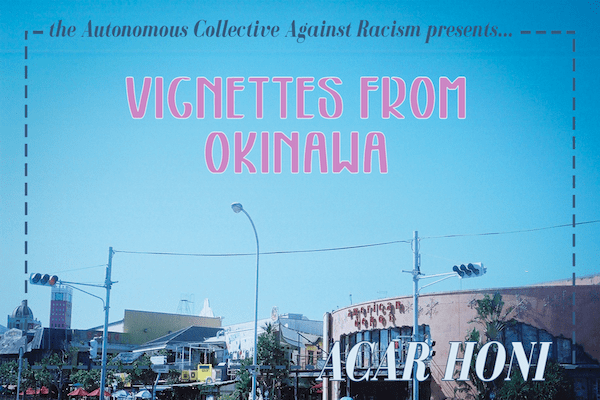The three hour plane ride from Tokyo down to Okinawa always feels longer than the nine hour ride from Sydney to Tokyo. I’m greeted with thick air as soon as I get off the plane, and the gentle, tinny strums of the sanshin echo endlessly throughout the terminal. I read and re-read the signs that warn me of accidentally smuggling out Okinawan potatoes as I wait for my luggage.
As I step out of the gates, yōkoso is replaced with mensōre, rāmen with Okinawa soba, and a horrifyingly efficient train system with Route 58 and backed up box cars.
I’ve never technically lived here, but coming back is always comforting. The sky feels lower and more vast here. I’ll reach up and fluff the clouds. I’ll drive alongside the ocean with all my windows rolled down whatever season it is (except for typhoon season). Sydney is physically my home, and in mainland Japan I’m just another small human within millions, and a tourist at that. But being in Okinawa with my family is something very precious.
My mum always taught me that we are uchinanchu, and that means we’re different to mainland Japanese people. I grew up immersed in Japanese culture, but my mum made sure to teach me about our Okinawan heritage too—that it’s important for us to understand and honour the past.
In 1879, Okinawa was annexed by the Japanese. Before it became incorporated into Japan as a prefecture, it was the Ryūkyū Kingdom. A tributary state to China, the dress, language, and culture was distinct to the tiny island. As soon as it was annexed, policies were put into place to assimilate the people into Japan, with the main focus being the eradication of the traditional language. My great-grandma could only speak Okinawan, my grandma is fluent in both Okinawan and Japanese, and my mum is only conversational in Okinawan. I can’t speak it at all. The disappearing language from our communities is one of the biggest ways that the younger generation are detached from older generations, and how traditions get lost in the past. Revitalisation efforts within the community have sprung up since the late 1990s, but with the teaching of it still banned within schools by law, most of the younger generations cannot speak it at all.
Okinawa’s relationship with Japan, and more recently the US, is complex and hard to know if you’re only looking at the surface. Okinawa is now a popular holiday destination for Chinese, Korean, and mainland Japanese tourists, and its modern rebranding as a resort getaway hides the often painful history. But once you venture out of places like Onna Village, where streets are lined with hotels and scuba diving agencies, or the shopping strip of Naha city, it becomes hard to ignore all of the fences.
Fences line many of the main roads, separating locals from American military bases. They remain on the island, even after the end of the US Occupation of Okinawa in 1972. Despite being less than one percent of Japanese land, over 70% of American military bases in Japan are located in Okinawa. These camps are closed to locals except for holidays like the 4th of July and New Year’s Eve, and loud rumbles of military planes are the norm. My little cousin likes to point out the Osprey planes from our balcony. My mum always sighs, and tells me the situation is so complicated.
Okinawa was the only inhabited place in Japan where battle took place during World War II. A quarter of all Okinawan civilians lost their lives during the three month battle between the American troops and the Japanese Imperial Army. Many of the civilians evacuated into the jungle, and whole families hid inside of traditional tombs, as well as in deep caves throughout the island. Not only were they caught between the two powers, but imperial propaganda encouraged local communities to commit mass suicides before they could be captured by American forces, in honour of the Japanese emperor. The role of the army in these mass suicides has not been acknowledged by the Japanese government, and these events are erased from school history textbooks.
Feelings towards Japan and the US vary throughout the generations, but my elders remind me not to forget these events in the past, and to recognise how they still manifest in our communities today.
A few weeks ago I talked to my grandma on the phone, and asked her how she would describe Okinawa to someone who has never visited. After a moment of thinking, she replied that she thinks it’s a good place. It’s close to the ocean, and quiet for the most part. When I asked my mum the same question, she replied in almost the exact same way. Her memories of running through sugarcane fields, climbing banyan trees, and living by the ocean contrast so greatly to the world she found outside.
When I think about what Okinawan culture is to me, I also think of the landscape. The castle ruins atop the many mountains. The narrow alleyways of homes with protective shīsā out the front. The road signs with place names that mainland Japanese people can’t read. While many things change, some things also stay the same. Pieces of Ryūkyū are still left in Okinawa in both big and small ways. I’m especially reminded of this during Obon festival in the summertime, when our ancestral spirits visit us for three days. This year my auntie sent us photos of the family shrine and the traditional feast that she had prepared. She told us she had done ūtōtō for us too. My cousin posted videos of eisā passing by his house, and it made me miss how the streets rumbled as people sang and danced and drummed into the early hours of the morning—a steady heartbeat carrying the past, through us, into the future.
add





